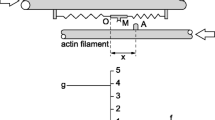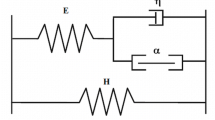Abstract
A mathematical model of skeletal muscle is presented which contains the two physiological control parameters stimulation rate and motor unit recruitment. The model is complete in the sense that it adequately describes all possible contractive states normally occurring in living muscle. The modelling procedure relies entirely on established myo-physiological facts and each assumption made is substantiated by experimental data. Extensive simulation studies reveal that the model is capable of correctly predicting practically all known phenomena of the muscular force-output. A simplified version of the model is also presented, particularly suitable for inclusion as the driving structure in complex musculoskeletal link systems. This version was successfully tested in the prediction of an optimal human motion. The present control model is believed to fill a gap in the literature on models of muscle, and may be expected to provide a sound basis for research into the optimal control aspects of muscular contraction, and to stimulate such research.
Similar content being viewed by others
References
Adrian, R.H., Chandler, W.K., Hodgkin, A.L.: The kinetics of mechanical activation in frog muscle. J. Physiol. 204, 207–230 (1969)
Alexander, R.S., Johnson, P.D.: Muscle stretch and theories of contraction. Amer. J. Physiol. 208, 412–416 (1965)
Aubert, X.: Le couplage énergétique de la contraction musculaire. Thése d'agregation. Brussels: Arscia 1956
Bahler, A.S.: Series elastic component of mammalian skeletal muscle. Amer. J. Physiol. 213, 1560–1564 (1967)
Bahler, A.S., Fales, J.T., Zierler, K.L.: The active state of mammalian skeletal muscle. J. gen. Physiol. 50, 2239–2253 (1967)
Bahler, A.S., Fales, T.J., Zierler, K.L.: The dynamic properties of mammalian skeletal muscle. J. gen. Physiol. 51, 369–384 (1968)
Bahler, A.S.: Modelling of mammalian skeletal muscle. IEEE Trans. Biomed. Eng. BME-15, 249–257 (1968)
Bawa, P., Mannard, A., Stein, R.B.: Predictions and experimental tests of a visco-elastic muscle model using elastic and inertial loads. Biol. Cybernetics 22, 139–145 (1976)
Bigland, B., Lippold, O.C.J.: Motor unit activity in the voluntary contraction of human muscle. J. Physiol. (Lond.) 125, 322–335 (1954)
Buchthal, F., Kaiser, E.: The rheology of the cross triated muscle fibre with particular reference to isotonic conditions. Dan. Biol. Medd. 21, 318 (1951)
Carlson, F.D.: Kinematic studies on mechanical properties of muscle. In: Tissue elasticity. Remington, J.W. Washington: Amer. Physiol. Soc. 1957
Chow, C.K., Jacobson, D.H.: Studies of human locomotion via optimal programming. Math. Biosci. 10, 239–306 (1971)
Close, R.I.: Dynamic properties of mammalian skeletal muscle. Physiol. Rev. 52, 129–197 (1972)
Constantin, L.L., Podolsky, R.J.: Evidence for depolarization of the internal membrane system in activation of frog semitendinosus muscle. Nature 210, 483–486 (1966)
Crowe, A.: A mechanical model of muscle and its application to the intrafusal fibres of the mammalian muscle spindle. J. Biomech. 3, 583–592 (1970)
Del Castillo, J., Katz, B.: Biophysical aspects of neuro-muscular transmission. Progr. Biophys. 6, 121–170 (1956)
Délèze, J.B.: The mechanical properties of the semitendinosus muscle at lengths greater then its length in the body. J. Physiol. 158, 154–164 (1961)
Desmedt, J.E., Hainaut, K.: Kinetics of myofilament activation in potentiated contraction: Staircase phenomenon in human skeletal muscle. Nature 217, 529–532 (1968)
Dragomir, C.T.: On the nature of foreces acting between myofilaments in resting state and under contraction. J. theor. Biol. 27, 343–356 (1970)
Ebashi, S., Endo, M.: Calcium and muscle contraction. Progr. Biophys. 18, 123–183 (1968)
Eberstein, A., Goodgold, J.: Slow and fast twitch fibres in human skeletal muscle. Amer. J. Physiol. 215, 535–541 (1968)
Eccles, J.C.: The understanding of the brain. p. 20. New York: McGraw-Hill 1973
Falk, G.: Predicted delays in the activation of the contractile system. Biophys. J. 8, 608–625 (1968)
Falk, G., Fatt, P.: Linear electrical properties of striated muscle fibres observed with intracellular electrodes. Proc. Roy. Soc. B 160, 69–123 (1964)
Fatt, P.: Skeletal neuromuscular transmission. In: Neurophysiology I. p. 204. Washington: Amer. Physiol. Soc. 1959
Fung, Y.C.B.: Mathematical representation of the mechanical properties of heart muscle. J. Biomech. 3, 381–404 (1970)
Gillis, J.M.: The site of action of Ca in producing contraction in striated muscle. J. Physiol. 200, 849–864 (1969)
Glantz, S.A.: A constitutive equation for the passive properties of muscle. J. Biomech. 7, 137–145 (1974)
Gordon, A.M., Huxley, A.F., Julian, F.J.: The variation in isometric tension with sarcomere length in vertebrate muscle fibres. J. Physiol. 184, 170–192 (1966)
Green, D.G.: A note on modelling muscle in physiological regulators. Med. biol. Eng. 7, 41–48 (1969)
Hatze, H.: A theory of contraction and a mathematical model of striated muscle. J. theor. Biol. 40, 219–246 (1973)
Hatze, H.: A model of skeletal muscle suitable for optimal motion problems. In: Biomechanics IV. (Nelson, R. C., Mourehouse, C.A. Eds.) Int. Ser. Sport Sci. 1, 417–422 (1974)
Hatze, H.: Optimal control aspects of the motion of a biological system. Proc. SACAC Symp. Control Theory, Johannesburg (1975)
Hatze, H.: The complete optimization of a human motion. Math. Biosci. 28, 99–135 (1976)
Haut, R.C., Little, R.W.: A constitutive equation for collagen fibres. J. Biomech. 5, 423–430 (1972)
Hefner, L.L., Bowen, T.E.: Elastic components of cat papillary muscle. Amer. J. Physiol. 212, 1221–1227 (1967)
Hill, A.V.: The series elastic component of muscle. Proc. Roy. Soc. B 137, 273–280 (1950a)
Hill, A.V.: The heat of shortening and the dynamic constants of muscle. Proc. Roy. Soc. 126B, 136–195 (1938)
Hill, A.V.: A discussion on muscular contraction and relaxation: their physical and chemical basis. Proc. Roy. Soc. (Lond.) B 137, 40 (1950b)
Hill, T.L.: Theoretical formatlism for the sliding filament model of contraction of striated muscle. Progr. Biophys. 28, 269–340 (1974)
Hodgkin, A.L., Horwicz, P.: Potassium contractures in single muscle fibres. J. Physiol. 153, 386–403 (1960)
Huxley, A.F.: Muscle structure and theories of contraction. Progr. Biophys. 7, 255–318 (1957)
Huxley, A.F., Taylor, R.E.: Local activation of striated muscle fibres. J. Physiol. 144, 426–441 (1958)
Huxley, A.F., Peachey, L.D.: Local activation of crab muscle. J. Cell Biol. 23, 107A (1964)
Huxley, A.F., Simmons, R. M.: Proposed mechanism of force generation in striated muscle. Nature 233, 533–538 (1971)
Jewell, B.R., Wilkie, D.R.: An analysis of the mechanical components in frog's striated muscle. J Physiol. 143, 515–540 (1958)
Jewell, B.R., Wilkie, D.R.: The mechanical properties of relaxing muscle. J. Physiol. 152, 30–47 (1960)
Jöbsis, F.F., O'Connor, M.J.: Calcium release and reabsorption in the sartorius muscle of the toad. Biochem. Biophys. Res. Commun. 25, 246–252 (1966)
Julian, F.J.: The effect of calcium on the force-velocity relation of briefly glycerinated frog muscle fibres. J. Physiol. 218, 117–145 (1971)
Laurie, D.P.: A numerical method for a certain class of improperly posed initial value problems. Int. Rep. 44, NRIMS/W/76/4 (1976)
Lowey, S., Slayter, H.S., Weeds, A.G., Baker, H.: Substructure of the myosin molecule. J. molec. Biol. 42, 1–29 (1969)
Marsden, C.D., Meadows, J.C., Merton, P.A.: Isolated single motor units in human muscle and thier rate of discharge during maximal voluntary effort. J. Physiol. 217, 12P-13P (1971)
Milner-Brown, H.S., Stein, R.B., Yemm, R.: The orderly recruitment of human motor units during voluntary isometric contractions. J. Physiol. 230, 359–370 (1973a)
Milner-Brown, H.S., Stein, R.B., Yemm, R.: Changes in firing rate of human motor units during linearly changing voluntary contractions. J. Physiol. 230, 371–390 (1973b)
Milner-Brown, H.S., Stein, R.B., Lee, R.G.: Synchronization of human motor units: Possible roles of exercise and supraspinal refflxes. Electroenceph. clin. Neurophysiol. 38, 245–254 (1975)
Natori, R.: Effects of Na and Ca ions on the excitability of isolated myofibrils. In: Molecular biology of muscular contration (ed. Ebashi, S. et al.). Amsterdam: Elsevier 1965
Needham, D.M. Machina carnis. Cambridge: University Press 1971
Norris, F.H.: Isometric relaxation of striated muscle. Amer. J. Physiol. 201, 403–407 (1961)
Oğuztöreli, M.N., Stein, R.B.: An analysis of oscillations in neuromuscular systems. J. Math. Biol. 2, 87–105 (1975)
Parmley, W.W., Sonnenblick, E.H.: Series elasticity in heart muscle: Its relation to contractile element velocity and proposed muscle models. Circ. Res. 20, 112–123 (1967)
Peachey, L.D.: The sarcoplasmic reticulum and transverse tubules of the frog's sartorius. J. Cell Biol. 25, 209–231 (1965)
Rack, P.M.H., Westbury, D.R.: The effects of length and stimulus rate on tension in the isometric cat soleus muscle. J. Physiol. 204, 443–460 (1969)
Ramsey, R.W., Street, S.F.: The isometric length-tension diagram of isolated skeletal muscle fibres of the frog. J. cell. comp. Physiol. 15, 11–34 (1940)
Ritchie, J.M., Wilkie, D.R.: The dynamics of muscular contraction. J. Physiol. 143, 104–113 (1958)
Soong, T.T., Huang, W.N.: A stochastic model for biological tissue elasticity in simple elongation. J. Biomech 6, 451–458 (1973)
Stark, L.: Neurological control systems. p. 311. New York: Plenum Press 1968
Stein, R.B., Oğuztöreli, M.N.: Tremor and other oscillations in neuromuscular systems. Biol. Cybernetics 22, 147–157 (1976)
Sugi, H.: Tension changes during and after stretch in frog muscle fibres. J. Physiol. 225, 237–253 (1972)
Thom, R.: Structural stability and morphogenesis. Massachusetts: Benjamin, 1975
Walker, S.M.: Potentiation and hysteresis induced by stretch and subsequent release of papillary muscle of the dog. Amer. J. Physiol. 198, 519–522 (1960)
Walsh, G.E.: Physiology of the nervous system. London: Longmans 1964
Wilkie, D.R.: The relation between force and velocity in human muscle. J. Physiol. 110, 249–280 (1950)
Wilkie, D.R.: Measurement of the series elastic component at various times during a single muscle twitch. J. Physiol. 134, 527–530 (1956)
Williams, W.J., Edwin, A.I.: An electronic muscle simulator for demonstration and neuromuscular systems modelling. Med. biol. Eng. 8, 521–524 (1970)
Woledge, R.C.: The thermoelastic effect of change of tension in active muscle. J. Physiol. 155, 187–208 (1961)
Yamada, H.: Strength of biological materials. Baltimore: Willams, Wilkins 1970
Yamashita, T., Frank, A.A.: A study of controllability of body motion in a biped by a linearized model. Proc. Jt. Autom. Control Conf., Austin, Texas (1974)
Zomlefer, M.R., Ho, R., Levine, W.S., Zajac, F.E.: A study of the coordination of cat hindlimb muscles during a maximal vertical jump. Proc. IEEE Conf. on Decision and Control, Houston, Texas (1975)
Author information
Authors and Affiliations
Rights and permissions
About this article
Cite this article
Hatze, H. A myocybernetic control model of skeletal muscle. Biol. Cybernetics 25, 103–119 (1977). https://doi.org/10.1007/BF00337268
Received:
Issue Date:
DOI: https://doi.org/10.1007/BF00337268




